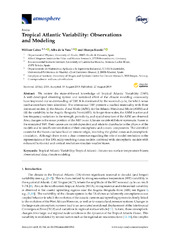Tropical Atlantic variability: Observations and modeling
Peer reviewed, Journal article
Published version

Åpne
Permanent lenke
https://hdl.handle.net/1956/21820Utgivelsesdato
2019-08-27Metadata
Vis full innførselSamlinger
- Geophysical Institute [1185]
Originalversjon
https://doi.org/10.3390/atmos10090502Sammendrag
We review the state-of-the-art knowledge of Tropical Atlantic Variability (TAV). A well-developed observing system and sustained effort of the climate modeling community have improved our understanding of TAV. It is dominated by the seasonal cycle, for which some mechanisms have been identified. The interannual TAV presents a marked seasonality with three dominant modes: (i) the Atlantic Zonal Mode (AZM), (ii) the Atlantic Meridional Mode (AMM) and (iii) the variability in the Angola–Benguela Front (ABF). At longer time scales, the AMM is active and low-frequency variations in the strength, periodicity, and spatial structure of the AZM are observed. Also, changes in the mean position of the ABF occur. Climate models still show systematic biases in the simulated TAV. Their causes are model-dependent and relate to drawbacks in the physics of the models and to insufficient resolution of their atmospheric and oceanic components. The identified causes for the biases can have local or remote origin, involving the global ocean and atmospheric circulation. Although there is not a clear consensus regarding the role of model resolution in the representation of the TAV, eddy-resolving ocean models combined with atmospheric models with enhanced horizontal and vertical resolutions simulate smaller biases.
